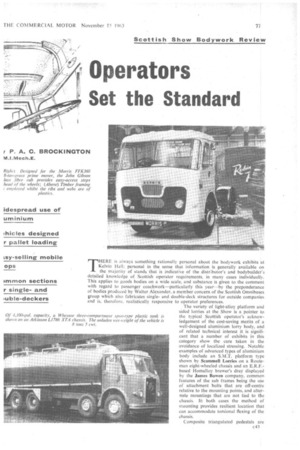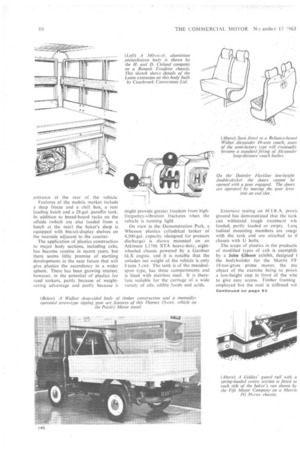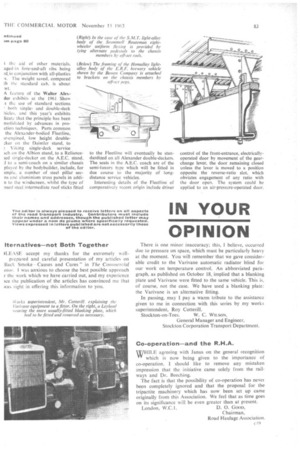Operators
Page 79

Page 80

Page 81

Page 82

Page 85

If you've noticed an error in this article please click here to report it so we can fix it.
Set the Standard
THERE is always something rationally personal about the bodywork exhibits at Kelvin Hall; personal in the sense that information is generally available on the majority of stands that is indicative of the distributor's and bodybuildefs detailed knowledge of Scottish operator requirements, in many cases individually. This applies to goods bodies on a wide scale, and substance is given to the comment with regard to passenger coachwork—particularly this year—by the preponderance of bodies produced by Walter Alexander, a member concern of the Scottish Omnibuses group which also fabricates singleand double-deck structures for outside companies and is, therefore, realistically responsive to operator preferences.
The variety of light-alloy platform and sided lorries at the Show is a pointer to the typical Scottish operator's acknowledgement of the cost-saving merits of a well-designed aluminium lorry body, and of related technical interest it is significant that a number of exhibits in this category show the care taken in the avoidance of localized stressing. Notable examples of advanced types of aluminium body include an S.M.T. platform type shown by Seammell Lorries on a Routeman eight-wheeled chassis and an E.R.F.based Hornalloy brewer's dray displayed by the dames Bowen company, common features of the sub frames being the use of attachment bolts that are off-centre relative to the mounting points, and alternate mountings that are not tied to the chassis. 16 both cases the method of mounting provides resilient location that can accommodate torsional flexing of the chassis.
Composite triangulated pedestals are c43
fitted to the S.M.T. body, which has an overall length of 24 ft., and the off-centre tie bolts are attached to clamp brackets on the lower flanges of the chassis members, the pedestals being separated from the upper flanges by timber packing pieces. Outrigger] brackets are bolted to the chassis members of the E.R.F. lorry, and plates attached to the sides of the body cross bearers are integral with pegs that extend downwards to the brackets through timber packing pieces. Additional support is given by longitudinal inverted channel-section members with timber inserts laid on the top flanges of the chassis members.
Although the Routeman body is a standard type, it is specially adapted to accommodate the large torsional deflections of the long chassis and the type of load carried. Despite the use of a heavyduty floor, designed for stillage loading, the complete body with headboard has a weight of only 10 cwt. The E.R.F. will also carry piloted loads.
An S.M.T. tipper body, displayed by the Foden company on a T.X. 6/24 eight-wheeled chassis, and an S.M.T.designed Pilot all-steel Bedford-based body on the S.M.T. stand are of special interest in that they are custom-built to cater for special user needs, the operators being the South of Scotland Electricity Board and Kings of Glasgow respectively. The fly ash to be carried in the tipp contains a high proportion of liquid, ar the tailboard is lined with easily replac able sealing strip to prevent leakage. T1 body and tailboard are of particular robust construction to reduce distortic to a minimum (otherwise the sealit would not be effective) and this is pr vided by the use of interlocking plan] and multiple bracing members, In adt tion to a lever-operated locking mecha ism, the tailboard is fitted with tur buckle clamps. whilst the lifting gear of the Pilot outrigged-ram type giving •• angle of tip of 55°. This is necessary dislodge the load if the slurry partial solidifies to form a jelly. • Developed for arduous quarry wor the S.M.T.-Pilot body incorporates ring-loaded mechanism giving autoitic release of the tailboard when the dy is raised, and this affords a valuable titig in operational time. The 6-cu.-yd. dy has a triple-laminated floor, coin[sing a 0-25-in. sheet of steel, a layer 15-in. hardwood and a 0.125-in. steel iet and is tipped by Pilot single-ram derbody gear, the hinge pins being card in fork-type heavy-duty brackets. iassis features include oversize tyres, .ee-piece wheels, heavy-duty two-speed le and 13-in. clutch.
Displayed by William Gillespie on a orris 5-ton chassis, a Cummings lightoy, pallet-loading van is equipped with o suspended sliding doors on each side, ,ing a full-length opening apart from ; centre pillar. Suspended doors are iployed in preference to the more conational type to enable guide rails (of ralumin) to be used in place of mers, which would be more easily maged by a fork truck. Each door is ed with two sets of top-and-bottom 1er-bearing-mounted rubber rollers ining in steel channels, which are .anged back-to-back to give parallel ivements. Other features include a
full-length plastics roof and aluminium roller shutters at the rear.
To be operated by the Robertson company for the delivery of jams and marmalades, mainly in highly-populated areas, the van is one of a number of similar vehicles recently supplied to the company and will be unloaded by fork truck at some of the larger premises as well as being loaded by the same means at the depot. A rubber fender strip on the sides offers protection against damage by the truck, and large rubber buffers at the rear safeguard the body when the vehicle is backed up to a loading deck.
Suspended doors with a similar type of roller gear are also fitted to the Johnson timber-framed, Thames-based palletloading van exhibited by the Croft company, which will be used by Brown and Poison for the carriage of flour, glucose, soups and so on between factory and wholesalers premises. In this case the parallel tracks are both facing outwards, the upper track overhanging the tower one and full-length opening is provided on both sides.
Noted for their interest in easy-loading devices, the Penman company exhibits a box van, mounted on an Albion Clay more chassis, which is equipped with the Joloda twin-trolley-and-track system for moving pallets forward from the rear of the vehicle after being loaded by fork truck. In this application the tracks are incorporated in a full-length mounting board located centrally on the vehicle deck, and the installation shows how the system can be employed without modification of the vehicle floor.
Designed for a wholesale fruit and vegetable merchant, an open-sided vehicle on a Karrier Gamecock chassis is exhibited by Hamilton Bros. Ltd., a particular feature of which is the use of plastics side curtaining that is virtually proof against tearing, it is claimed, even if slashed with a sharp knife. A wide variety of produce is carried packed in containers of differing shapes and size and there is no alternative to manual loading. Protection against the weather is required, combined with full-length loading facilities, and curtains offer free side access to the entire platform area. This could not be obtained with sliding doors, which, moreover would be easily jammed by the odd-shaped packages.
As usual a relatively high percentage of the vehicles comprise mobile shops, and special mention is appropriate this year of the two vehicles in this category displayed by the Fife Motor Co. Ltd. Built by John Jackson and Sons to a Fife design, a provision merchant's mobile market on a Morris 3-ton chassis enables the goods to be "sold from the centre" and this also applies to a Morris-based baker's shop, the latter vehicle being equipped with a kiddies' spring-loaded guard rail on both sides to prevent small children crawling under the panels. There have been many accidents from this cause.
Both vehicles have a sliding door on the left side behind the driving compartment which gives access to a threequarter-length counter, and customers are brought into closer average proximity with the goods than that provided by more conventional counter arrangements. Moreover, it is considered that a side entrance offers greater safety than an entrance at the rear of the vehicle.
Features of the mobile market include a deep freeze and a chill box, a rear loading hatch and a 28-gal. paraffin tank. In addition to bread-board racks on the offside (which are also loaded from a hatch at the rear) the baker's shop is equipped with biscuit-display shelves on the nearside adjacent to the counter.
The application of plastics construction to major body sections, including cabs, has become routine in recent years, but there seems little promise of startling developments in the near future that will give, plastics the ascendancy in a wider sphere. There has been growing interest. however, in the potential of plastics for road tankers, partly because of weightsaving advantage and partly because it might provide greater freedom from highfrequency-vibration fractures when the vehicle is running light
On view in the Demonstration Park, a Whessoe plastics cylindrical 'tanker of 4,100-gal. capacity (designed for pressure discharge) is shown mounted on an Atkinson L1786 XTA heavy-duty, eightwheeled chassis powered by a Gardner 6LX engine, and it is notable that the unladen net weight of the vehicle is only 8 tons 5 cwt.The tank is of the mandrelspun type, has three compartments and is lined with stainless steel. It is therefore suitable for the carriage of a wide variety of oils, edible foods and acids.
Extensive testing on provii ground has demonstrated that the tank can withstand rough treatment will loaded, partly loaded or empty. Lam tudinal mounting members are integr with the tank and are attached to it chassis with U bolts.
The scope of plastics in the productic of modified types of cab is exempliffi by a John Gibson exhibit, designed I the bodybuilder for the Morris FF 18-ton-gross prime mover, the ma object of the exercise being to prOvii a low-height step in front of the whe to give easy access. Timber framing employed but the roof is stiffened wit
t the aid of other materials, aged-in fore-and-aft ribs being in conjunction with all-plastics 5. The weight saved, compared Lb the standard cab, is about wt.
A feature of the Walter Alexder exhibits at the 1961 Show s the use of standard sections • both singleand double-deck hides, and this year's exhibits Iicatc that the principle has been asolidated by advances in proction techniques. Parts common the Alexander-bodied Fleetline, tr-engined, low height double:..ker on the Daimler stand, to ; Viking single-deck service tch on the Albion stand, to a Relianceied single-decker on the A.E.C. stand, 1 to a semi-coach on a similar chassis played by the bodybuilder, include, for imple a number of steel pillar seens and aluminium truss panels in addin to the windscreen, whilst the type of ;ssed steel intermediate roof sticks fitted to the Fleetline wilt eventually be standardized on all Alexander double-deckers. The seats in the A.E.C. coach are of the semi-luxury type which will be fitted in due course to the majority of longdistance service vehicles.
Interesting details of the Fleetline of comparatively recent origin include driver
control of the front-entrance, electricallyoperated door by movement of the gearchange lever, the door remaining closed unless the lever is moved to a position opposite the reverse-ratio slot, which obviates engagement of any ratio with the door open. The system could be applied to an air-pressure-operated door.








































































































































